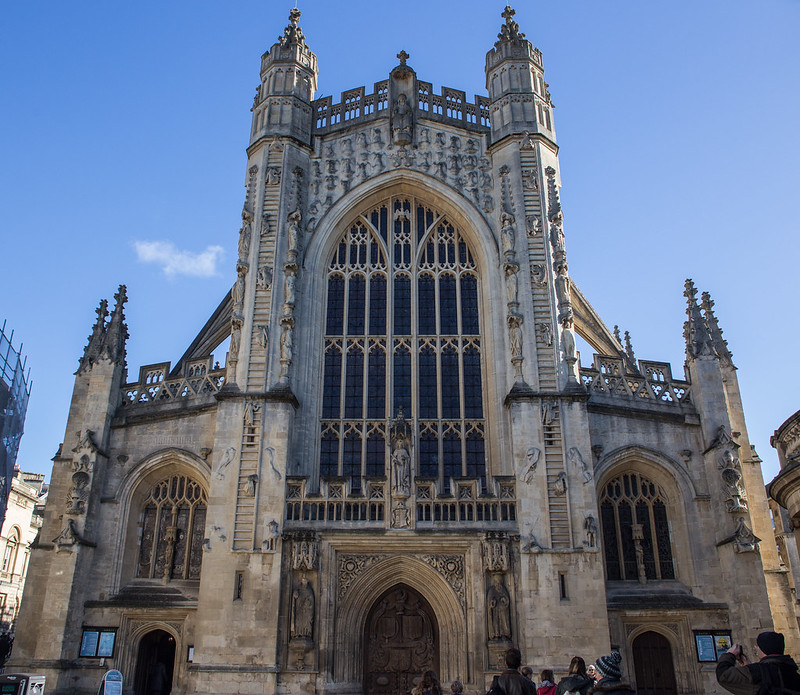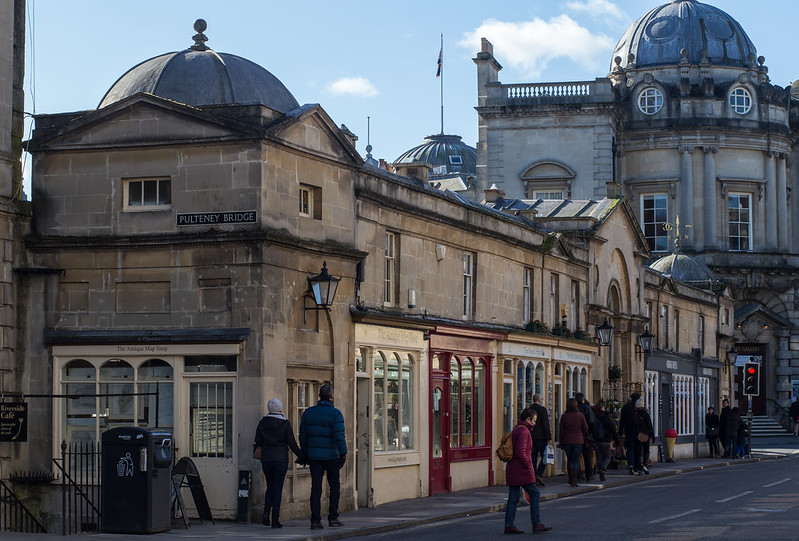What to Explore in Bath, England
One of my favorite cities I’ve visited in England has to be Bath. It’s a quick 15 minute train ride from Bristol, located in Somerset near the west coast. Jane Austen aficionados will probably recognize Bath as a oft-mentioned locale in her novels, and I admit that as an Austenite I couldn’t resist the chance to visit. But as I discovered, Bath has much more to offer than fulfillment of my Austen fantasies!
Firstly, Bath is an incredibly picturesque city, so be sure to bring a camera. Most of the buildings, especially those in the city center, are built from Bath Stone, which is slightly golden colored, and large portions of the current city date from the 18th and 19th century, with a distinctly Georgian style throughout the architecture. The light-colored stone contrasts in a lovely way against the rooftops and pavements, which really lends itself to postcard-worthy snapshots.
 Streets of Bath
Streets of Bath
The city of Bath was built up over time around the local hot springs. The hot springs were known as a sacred healing place prior to the Roman invasion of Britain, tracing back to the building of a Celtic temple dedicated to the goddess Sulis, but the Romans were really the first to build a full bathing complex incorporating the hot springs around 70 AD, which lead to a town growing up around the baths. The Romans called the town Aquae Sulis, meaning the waters of Sulis, keeping the name from the original temple. The baths existed until the Romans withdrawal in the 5th century, when they fell into disrepair and were basically lost. But now you can visit the excavated original Roman Baths, where you are able to walk around the complex and get a sense of what it would have been like to spend a day bathing as a Roman.
 Inside the ancient Roman Baths
Inside the ancient Roman Baths
While the Roman Baths complex is purely a museum and historical site now, and not used for bathing, you can still experience the hot springs at the nearby, more modern facilities of the Thermae Bath Spa. Featuring both modern and historical spa conveniences, this is the place to enjoy the mineral-rich waters that have attracted people to Bath for centuries.
Besides the hot springs, Bath has many buildings and locations of architectural and historical interest that are worth making time for during your visit. Bath Abbey is located next to the Roman Baths complex, and is an impressive Gothic structure dating back to the 12th century. The interior has beautiful fan vaulting similar to vaulting featured in Westminster Abbey.
 Bath Abbey
Bath Abbey
From the Abbey, you’re a short walk away from Pulteney Bridge and Great Pulteney Street. Pulteney Bridge was built in the 18th century as both a bridge over the River Avon and a shopping arcade, similar to the Rialto Bridge in Venice. It is one of the few surviving bridges in Europe that still has a dual purpose as such. Stop in some of the small shops on your way across, or grab a coffee in one of the several cafes that look out over the river.
Heading east over the bridge will take you along Great Pulteney Street, the widest street in Bath. Both sides of the boulevard feature grand Bath Stone facades of Georgian-style terraces. Plus, at the end of the street is The Holborn Museum, housed in the former Sydney Hotel building dating from the late 18th century, and the surrounding Sydney Gardens, which are the only remaining 18th century pleasure gardens in the country. Jane Austen frequented the gardens while living in Bath, mentioning these in letters to her sister as one of the most pleasant features of her time in Bath.
 Pulteney Bridge shops, above. Great Pulteney Street terraces, below.
Pulteney Bridge shops, above. Great Pulteney Street terraces, below.

My favorite building to visit is the Royal Crescent, one of the most recognizable architectural landmarks of Bath. Another a perfect example of Georgian architecture, the crescent features 30 terraced houses and was built in the late 18th century. Interestingly, the public facade was the only thing explicitly designed as a whole; the original owners bought a length of the facade, and then proceeded to build their accommodations behind the facade to their own desires. When viewed from above, there’s quite a difference between the uniformity of the public crescent and the varying back views of the individual homes.
No. 1 Royal Crescent is currently established as a museum, and has been restored to reflect the living style of the owners in the late 18th century. The guides inside are very informative, and it’s a great way to see all the antiques and daily tableaus of the wealthier families of that time.
 The Royal Crescent, above. Interior of No. 1 Royal Crescent, below.
The Royal Crescent, above. Interior of No. 1 Royal Crescent, below.

If you visit Bath on a sunny day, take advantage of the numerous parks and nature areas in the city. Next to the Royal Crescent, you can enjoy Royal Victoria Park, which includes a boating pond, a children’s play area, botanical gardens, and a myriad of other outdoor attractions. For a fantastic view of the city, explore Alexandra Park, walkable from the city center if you’re feeling energetic, or just a quick bus ride from the city center. And then slightly further out is the extremely picturesque Prior Park Landscape Garden, perfect for photographers and nature lovers alike.
Learn more about Prior Park Landscape Garden
These are just some of the things you can do in Bath - it’s really a marvelous city to visit, chock full of history and beautiful architecture, but still small enough that you avoid the typical hustle and bustle of a European city. Spend a few days here exploring the city, wandering the parks, and enjoying the mineral waters, and you too can leave refreshed as those who pilgrimaged here for the hot springs centuries ago.